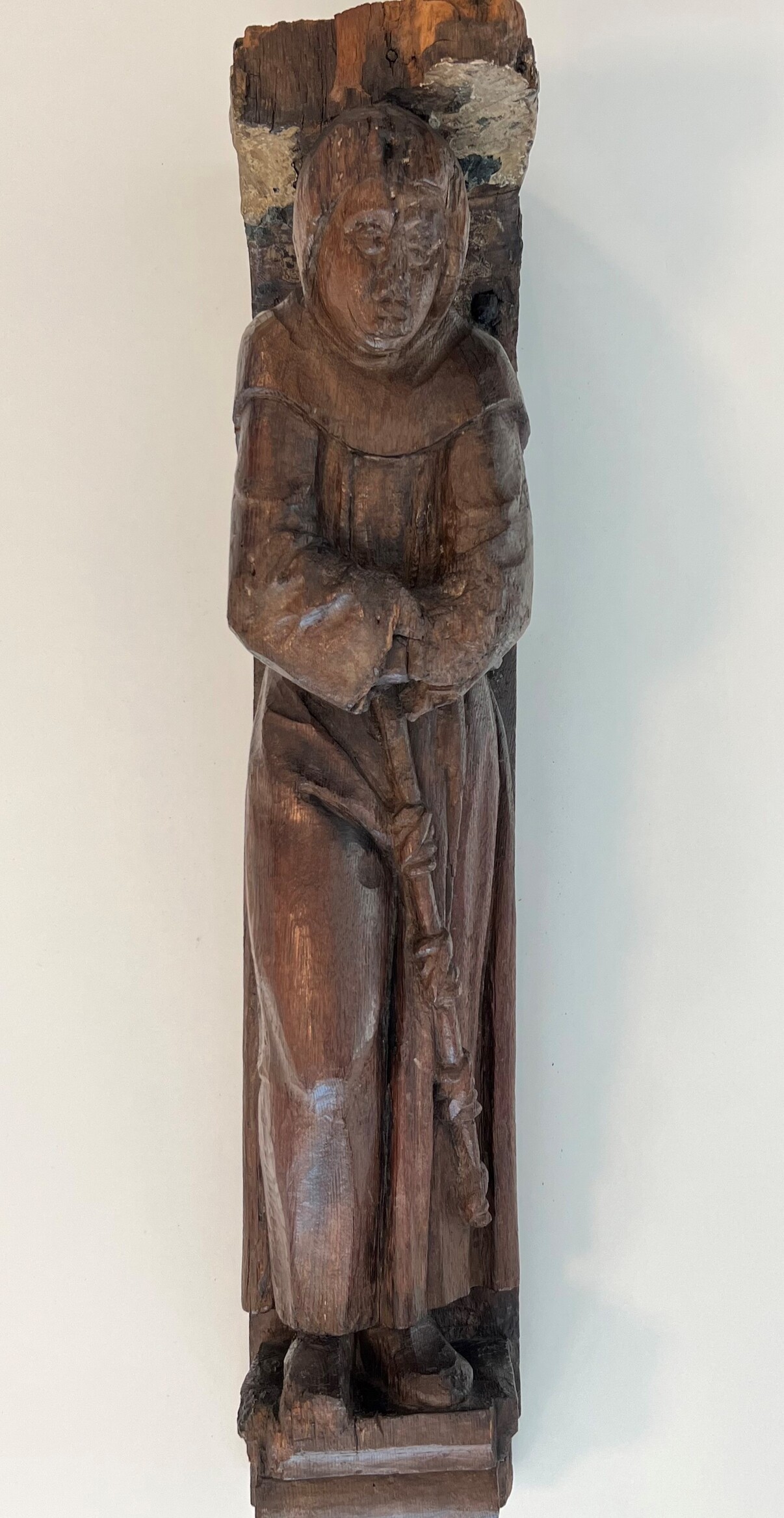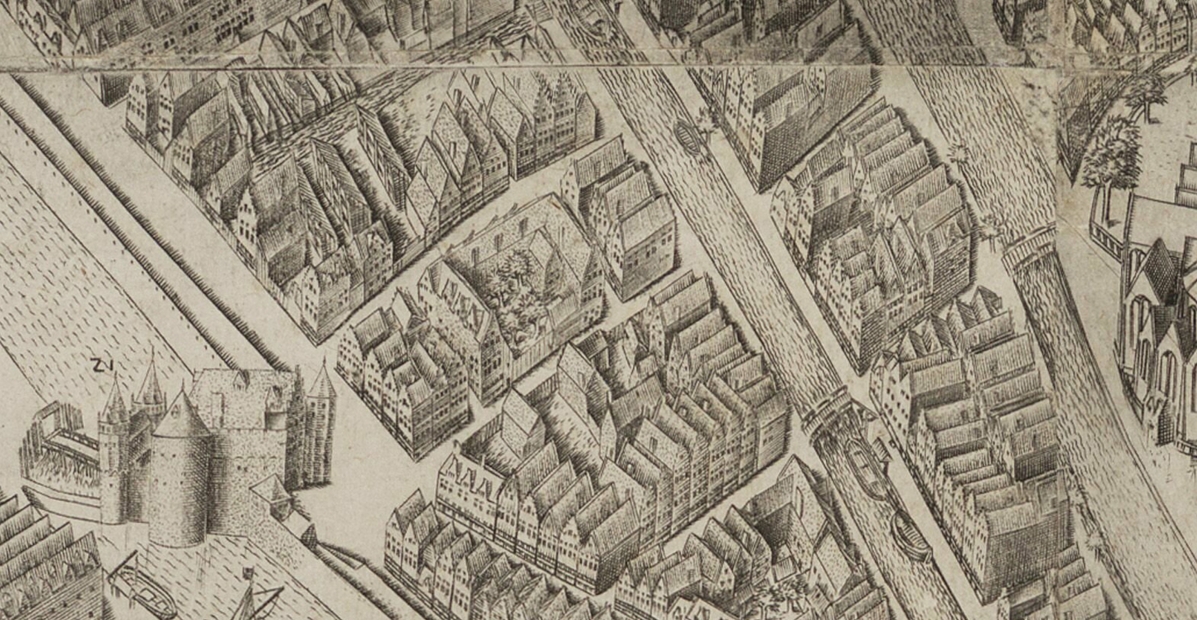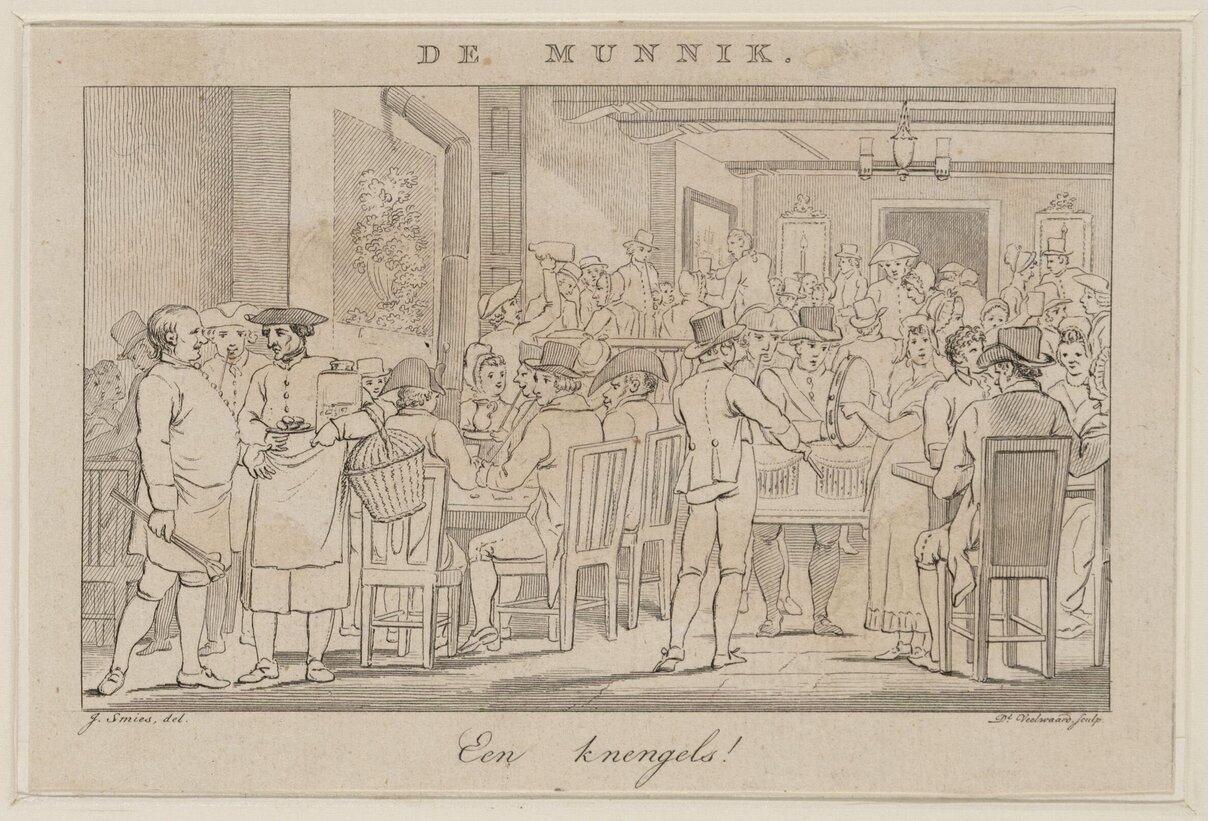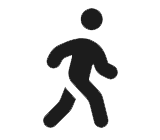The history of a trestle statue
Since 1884, museum Ons' Lieve Heer op Solder has owned a wooden trestle statue. A habit cord with three buttons makes it clear that this represents a Friar Minor. The statue is made of oak and 82 cm high. Before it entered the collection, it sat for a long time on the facade of a house in the city. It was home to a popular pub called 'Het Munnikje' in the 19th century. At the museum, this sculpture hung in the church room for a long time. Today, it is in the depot.

The trestle statue as it looks anno 2024.
How old is the statue?
Because of stylistic features such as a certain movement - see the protruding leg and swaying cord - and the realistic body proportions, the sculpture cannot date earlier than about 1520. That is when such Renaissance features tentatively made their appearance in the Netherlands. However, the monastery of the minor friars in Amsterdam was founded as early as 1463. So the statue must have been placed later. Nothing is known of the monastery's building history, so when the statue came to the monastery and where it was placed remains unclear. It will have had a place somewhere in the monastery church.
Where has the monastery gone?
As early as 1566, the monastery was looted during the iconoclasm. The trestle statue probably sits too high to be damaged. Protestant ideas did not take root in Amsterdam by then and the friars soon returned to their monastery. In 1578, the curtain does finally fall for them. The hated friars are expelled from the city with the Catholic city council.
In 1581, mayors and (then Protestant) church wardens sell the first land on the former monastery grounds: four plots bordering the Oudezijds Achterburgwal, partly situated on the old churchyard. One of the four plots later plays an important role in the history of the trestle. The minor brother church itself is demolished in 1588. The alley next to it was widened and has since been called Monnikenstraat. Pieter Bast's city map of 1597 clearly shows that where the cemetery had been barely 20 years earlier, everything was built up. This applies to almost the entire monastery grounds. However, the pattern of streets and alleys still shows something of the original monastery plan.

The houses diagonally above the city gate on the lower left stand on the grounds of the former Friar Minor Monastery.
After demolition
The statue was probably still 'just' in the monastery church until 1588. But after that? That remains guesswork. Until 1710. Then it turns up again. In 1710, Dirk Braambergen and Fijtje Dirckx sold a property on the corner of Monnikenstraat and Oudezijds Achterburgwal. The deed of sale describes the property as 'there the munnick stands above the door'. It is exactly the place where there was a convent entrance until 1578. Who are these Dirk and Fijtje? And did they put the monk in the facade?
Dirk and Fijtje married in 1697. This is evident from a marriage certificate kept in the City Archive. They then owned several properties, including the one on the corner of Monnikenstraat, which they sold in 1710. Earlier deeds surrounding this property do not mention Monk. So it seems that the statue was placed on the facade sometime between 1697 and 1710. Later sources also mention a statue of a monk on the facade on this corner. It is said to have come from the Friar of Friars Minor. It is the statue that later ends up in the museum.

The Little Monk at the corner house of Oudezijds Achterburgwal 59 and Monnikenstraat.
A monk on the facade
In medieval Amsterdam, there are several houses where so-called "the monk hung out", i.e. where there is a sign on the facade with a monk on it. They are often (neighbourhood) pubs. Some monks are hefty takers, and thus sought-after pub patrons. A monk sign is therefore not strange. And that did not change after the Alteration of 1578. The monk hanging signs just keep on hanging. Good advertising!
However, a statue, clearly recognisable as a monk, nota bene from a disbanded monastery, is something else than a signboard. Putting such a statue on your facade, that would not have happened soon after the Alteration in a city where Catholic expressions in public spaces are not tolerated. But sometime between 1697 and 1710, Dirk and Fijtje dared to do it.What else do we know about them? Dirk is mentioned twice as a witness at a Catholic baptism, once Fijtje is also listed as a witness. These baptisms took place in house- or sheltered churches, where Catholics could profess their faith after 1578. So Dirk and Fijtje are most likely professing Catholics, which supports their possibly active role in placing the statue on the facade. The history of Amsterdam's monasteries was certainly not forgotten around 1700. One knows well where they stood. The corner Oudezijds Achterburgwal/Monnikenstraat was once a monastery entrance. A prime location to place the little monk and keep the memory somewhat alive! Apparently, this was no longer a problem in public spaces in those days.

Interior of the busy taproom and theatre 'Het Munnikje' at Oudezijds Achterburgwal 59.
There you are ...
For many years, the statue stood in all weathers. The pipe is painted reddish-brown, face and hands are coated with white-yellow putty. Many think it is a stone statue. Sometime around 1800, the statue even becomes the namesake for a taproom cum theatre in the corner building, also called a musico. 'Het Munnikje' is a well-known establishment. You can have a knengels there (a jug of English beer) and enjoy all kinds of folk entertainment. You have to watch your beer though, if you put it down for a moment someone else might just knock it over in the crowd!
To the museum
The statue remained on the facade until 1880. The musico is defunct by then. The building was bought by the 'Jongelingsvereeniging onder den Handwerksstand', which demolished it for new construction. The little monk must have been removed from the facade at the time. A few years later, it ended up in the collection of the Ons' Lieve Heer op Solder Museum. There it is cleaned and it is discovered to be made of wood. As mentioned, it hung in the church hall for years and is now kept in the depot.
Arjan Vader
Museum guide Our Lord in the Attic Museum
Last edited
October 29, 2024
The Grau Monks Monastery, in flat form, after life, maker unknown, c. 1730, print from the 18th century after Joost Jansz. Bilhamer from 1578. Collection Rijks Museum.
Trestle statue of a Friar Minor, maker unknown, c. 1520, 82 x 17 x 24 cm. Collection Museum Ons' Lieve Heer op Solder. Photography Robert Westera.
Amstelredam, Pieter Bast, 1597(Map of the city, pictured here a cutaway of the area around the Friar Minor Convent).Collection Atlas Splitberger. Stadsarchief Amsterdam.
The Monk at the corner house of the O.Z. Achterburgwal and Monnikenstraat (seen from the front and side), J.E. ter Gouw, 1845-1860, drawing, pen and brush in colour. Collection Stadsarchief Amsterdam.
A Knengels!, Daniel Veelwaard and Jacob Smies, 1800-1815, engraving. Atlas Dreesmann collection. Amsterdam City Archive.
Brugmans, H., Geschiedenis van Amsterdam II, 2de herziene druk (Amsterdam 1972) 53-55.
D’Ailly, A.E., Historische Gids van Amsterdam 22 (Amsterdam 1929) 91-92.
Hombergh, F.A.H. van den, ‘Brussel of Brugman. Opwinding rond de oprichting van het Amsterdamse Observantenklooster in 1462/63’ in: Jaarboek Amstelodamum 83 (Amsterdam 1991) 13-44.
Klijn, M., ‘Hooggeplaatste figuren in hout. Gesneden beelden en koppen aan Hollandse kerkgewelven' in: Bulletin van de Stichting Oude Hollandse Kerken, 54 lente (2002) 3-25.
Lennep, J. van en J. ter Gouw, De Uithangteekens, in verband met geschiedenis en volkslevens beschouwd, Tweede deel (Amsterdam 1868) 126.
Veerkamp, J., ‘Bedelmonniken bij de Nieuwmarkt. De broeders van Philips en Alva' in: Ons Amsterdam April (Amsterdam 2002) 154-157.




